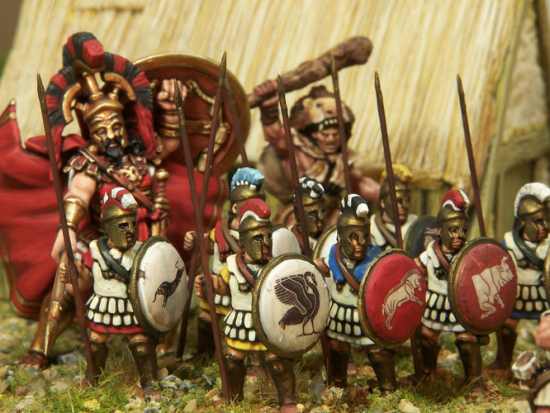Of Gods and Mortals
The Osprey series of “blue” wargames is one of my favorite things as they are high-production value, low-cost, and quick rulesets that allow you to get your feet wet with different systems and styles of wargames for a low cost. Not every single game in the line is my cup of tea, but so far I have been impressed with the variety. There are some I like more than others, but everyone has given me food for thought on my own attempts to build games.
This game focuses on mythical combat between rival gods and their followers. This allows a great space for heroic and high fantasy style games, or “Homeric” style battles. The game itself is intended for relatively small warbands but I could see an ambitious player scaling the rules up very easily to allow for larger Mortal armies. In a pinch, I could see people even using it for Old World style Warhammer.
Like
A Fistful of Kung-fu this is a re-skin of the
Song of Blades and Heroes skirmish system for fantasy settings. If you read my
Fistfull of Kung-Fu review you know how I felt about that system, so let’s see what
Of Gods and Mortals have done with it.
What I LikedThe Gods Units and the Mortal Units have a synergy. The Gods are more powerful, but Mortals can boost a god’s abilities, pray them back to existence, and Mortals are what keeps an army on the table. That means, Gods are the big bad units, but Mortals are not relegated to Cheerleader status. You have to play each unit to its strengths and minimize their weakness, in a way that was reminiscent to me of a lighter version of Napoleonic games or War Machine
This game uses the great push-your-luck/resource management initiative system of
A Fistful of Kung-Fu. When you activate a unit you roll up to 3 dice looking for their Quality score. Failures allow your opponent to react and possibly turn over initiative to your enemy. However, the more successes you get, the more your unit can do. Therefore, when you pick up the dice you have to weigh the risks vs. the rewards.
Gods clashing could lead to a big “explosion” of power that would Awe nearby troops. Once Awed, they were vulnerable to attacks and had to shake off the effect. In addition, gods could not actually be killed it there are enough mortal units available to pray. Then they can be brought back to the game.
I didn’t mention them in the
Fistful of Kung-Fu rules review, but both games use an interesting deployment method. Instead of deploying at the edge of the board in a certain box, units can pretty much be placed anywhere, as long as they are a certain distance from the objectives/enemy. This provides a great deal of choice when it comes to deployment and how you want your attacks or defense to develop. I would be really interested to see how this plays out on the table-top.
Things I Do Not LikeMuch of what I said about
A Fistful of Kung-Fu applies to these rules as well. I am not a fan of the level of abstraction in these rules. A few more stats would help differentiate the Legends, gods, and mortal followers a bit more. The two stats they do have cover way too many things. Sure, gods can be great at everything, but should a goddess of love be as good at everything as a god of war? The Special Rules differentiate their power sets, but not their actual abilities, if that makes sense.
The pages and pages of special rules are still a downer. Tied to this, the rules are littered with little asides where if X is true Y happens, but if Z is true then W happens. This should be covered in the Special Rules section and not the rules themselves. It will make it difficult to find the effects of some of the special rules in mid-game which will slow down gameplay. I recommend a good stat/reference sheet for each of your units be handy to help mitigate this somewhat.
I really am not a fan of how the Close-formation units move. They are either in a block or a straight line. The straight line isn’t a linear formation, but more of a conga line used to move through narrow areas and between terrain. It feels gamey reading it. In addition, all movement is in a straight line whether you are a block of troops, open-order troops, or an individual unit. You can pivot before a move, but ultimately you are going straight. The moving rules are simple and elegant but very gamey.
 Meh and Other Uncertainties
Meh and Other Uncertainties The game comes with some scenarios to play out which is always good. They are nothing mind-blowing, but the unique deployment rules will help make them re-playable.
If enough mortal units are destroyed, then the army falls apart no matter how many legends and gods are still on the table. Therefore, you have to balance your force with the right mix of units to keep it hard hitting, but not too fragile. Mortals are weaker than gods and legends, but their numbers allow them to stand up to the bigger hitters. However, the morale rules are pretty basic and would lead to armies going to the last man except for some arbitrary restrictions placed on it.
The book has army lists for Norse, Greek, Egyptian, and Celtic gods and legends. It doesn’t cover all the potential gods, but the big hitters. The website has even more army lists on the Osprey website, and a few of the lesser gods. However, the book also has a “unit builder” which is really neat. That way you can create a Babylonian army led by Ishtar the goddess, supported by Gilgamesh in war chariot, and Ikkidnu on foot, and a few units of archers and spearmen to back them up. You could even get into other Fantasy genres with a bit of thought.
Finally, the art and photos in this book are really good. Plus, it has diagrams!
Final ThoughtsWell, I think I decided that I am simply not a fan of the
Song of Blades and Heroes base engine. I can’t shake the feeling that it would get repetitive very quickly. Despite all the chrome, the core mechanics do not seem that engaging to me with the few exceptions I noted about Activation and Deployment.
However, the game itself seems like it would be great for a quick evening of gaming with buddies where you could play a 3-4 game campaign in a single evening. This would also make a fun Convention game where people are likely to be one-and-done players.
Ultimately, I see this as a side game and not a core game. If you had a nice Ancient army this would be fun to pick-up, add a model or two for gods and legends and have a fun, diverting side-game. I could also see this as fun if you are building a larger Ancients army for another game. However, I don’t really see building a warband just for this game.









